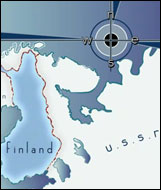

Finland - Economic Development
Historically, Finland’s economy was based on its abundance of lumber and its agriculture. But the nation’s economy had been damaged by interruptions in trade following the Russian Revolution, World War I and Finland’s civil war, which followed the birth of the Finnish republic in 1917.
During the early years of independence, Finland was dependent on aid from the U.S. to feed its people, but growing trade with Europe began to improve the nation’s economy. Lumber, pulp and paper accounted for about 85 percent of Finland’s exports which brought in enough currency to import half the nation's food supply and most of its manufactured goods. In contrast to the Soviet Union, Finland instituted an agricultural reform policy that redistributed agricultural and forest land among a larger percentage of the population, which now had a direct self-interest in improving productivity.
The government did nationalize a large portion of its mining and the wood-processing industries and invested public funds to modernize mines, foundries, wood and paper mills and shipyards to process and ship the raw materials.
The Great Depression of the 1930s, led to widespread hardship in Finland. Farmers shifted from producing for export to producing for internal consumption, which prevented famine and alleviated hunger but did not generate funds needed for additional investments in industry, manufacturing or in modernizing its armed forces. As a result, when the Winter War began, Finland’s comparatively small army had virtually no modern weapons.
Soviet Union- Economic Development
By 1927 Stalin had gained complete control of the Communist Party. He used his power to institute policies to radically transform the Soviet Union economically. These policies were implemented through a system of central planning with five-year targets for rapid industrialization and the collectivization of agriculture. At the same time, there were huge allocations for the Red Army.
The First Five Year Plan, from 1928 to 1932, concentrated on heavy industries such as mining, machinery, electrical power generation and railroad construction. Many new factories were built to produce goods such as automobiles, tractors and steel. During this period industrial production more than doubled.
The development of heavy industry and manufacturing also allowed for the production of vast numbers of tanks, aircraft, artillery and other modern weapons. Military leaders developed a doctrine of mobile mechanized warfare to utilize these new resources.
The Second Five Year Plan, from 1933 to1937 was first intended to pay more attention to consumer goods, but with the growing threat of war, there was an increased emphasis on heavy industry. The production of armaments and weaponry increased as well.
By the end of the 1930s, the Five Year Plans turned the Soviet Union into a major industrial power, behind only the United States and Germany. And the Soviet Red Army became the largest and most technologically advanced army in the world.
The Soviet Union’s drive to modernization came with a heavy cost in the lives of millions who died during widespread famines, who were executed or deported for resisting government policy, and millions more who were imprisoned or otherwise conscripted into forced labor.





